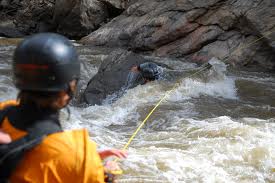 V-Lowers take time to set up properly. Always use a rescue vest so you can make a fast get-away. In heavy turbulent water, the rescuer may porpoise and get pulled under water periodically. The belayers and rescuer work as a single team, good communication via hand signals is vital. V-Lowers with a raft are usually a bit safer if set-up correctly. Overweight the downstream end of the raft so it doesn't take on water. A quick release knot is an important part of the set-up. As with most rescues, set appropriate downstream safety.
V-Lowers take time to set up properly. Always use a rescue vest so you can make a fast get-away. In heavy turbulent water, the rescuer may porpoise and get pulled under water periodically. The belayers and rescuer work as a single team, good communication via hand signals is vital. V-Lowers with a raft are usually a bit safer if set-up correctly. Overweight the downstream end of the raft so it doesn't take on water. A quick release knot is an important part of the set-up. As with most rescues, set appropriate downstream safety.
The main advantages of this technique is the ability to position a raft or person at the accident site with pinpoint accuracy. If lowering a raft into position, this typically provides a very stable rescue platform to work from. Some of the main drawbacks are it takes a fair amount of time to set-up and setup is often very complex. It is pretty easy to lower persons but very challenging to move back upstream. Use of a single wrap around a tree is often necessary as the forces are far higher than most people expect. Many fail to set a deep enough angle, a 45o angle or less is ideal - basically a very deep V.
